Author: Spike @ Contributor of PermaDAO
Review: Xiaosong HU @ Contributor of PermaDAO
Since its establishment, Arweave SCP Ventures has aimed to promote the widespread adoption of Arweave. Since the upgrade to Arweave 2.6, the Arweave ecosystem has entered a small period of prosperity. In order to fully demonstrate this progress, SCP Ventures, together with Forward Research and everVison, have jointly written this report for readers to enjoy.
Key Insight
1. Arweave enters a data explosion period. The Arweave network size has exceeded 100 PB, with over 1 billion transactions on the mainnet, over 100 million transactions on Bundlr, over 10 million transactions on everLianGuaiy, and a 933% increase in the number of developers in 3 years.
- a16z Dialogue with Solana Co-founder Why didn’t Solana become an EVM-based public blockchain?
- Highly dependent on the cycle, trapped in a regulatory predicament, is ‘cryptocurrency first stock’ Coinbase worth investing in?
- Mintlayer Research Report POS-based Layer 2 Protocol Empowers Bitcoin DeFi Ecosystem
2. The Arweave 2.6 upgrade marks a new era of underlying innovation. Mechanical hard drives can participate in mainnet mining, and the value weight of rare data will increase.
3. The foundation of the creator economy is complete. The combination of UDL (Universal Data License), UCM (Universal Content Marketplace), and $U will change the face of the creator economy in the next era.
4. Arweave ecosystem development is steadily progressing in the bear market. The number of projects in the ecosystem has exceeded 130, covering various fields such as development tools, DeFi, NFT, DDB, storage, RWA, content, and DePIN. Arweave’s ecosystem projects are well-prepared for the next bull market.
5. Developers will have more developer tools. Currently, there are a total of 62 active developers in the Arweave open-source community. Forward Research, everVision, and Community Labs are the main driving forces. EverID and Permaswap have made sufficient preparations for mass adoption, and achieving 1 billion users is the next goal for Arweave.
6. With the help of SCP theory, Arweave has moved from cold storage to hot computing and from static to dynamic. The significant performance improvement brought by the separation of storage and computation will allow developers to fully meet users’ arbitrary needs and eliminate the performance limitations and user barriers of public chains.
LianGuairt I: Introduction to Arweave
Unlike storage public chains as we usually know them, Arweave has unlimited scalability and the ability to connect to any public chain, DeFi, NFT, and other applications. Generally speaking, Arweave is a mainstream Layer 1 public chain that still adheres to the PoW mechanism and operates in a decentralized manner.

Image description: Blockweave Structure
Image source: The Block Research
SCP Ventures will briefly review the uniqueness of Arweave. The following mechanisms constitute the main technical components of Arweave:
- SPoRA (Succinct Proof of Random Access): In the process of participating in Arweave mining, miners need to access not only common predecessor and successor blocks but also randomly recalled blocks to ensure multiple backups of network data. Under the current mechanism design, any data is stored in at least nearly 1,000 copies.
- SmartWeave: This is Arweave’s version of smart contracts. Unlike Ethereum’s “off-chain storage + on-chain computation” mechanism, Arweave adopts the design concept of Lazy Evaluation, which can be understood as the reverse of Ethereum – “off-chain computation + off-chain storage”. Therefore, Arweave has the strongest data availability and unlimited scalability among current public chains.
- Permanent storage: Arweave does not have an issuance mechanism. When users pay storage fees with $AR, a portion of the funds will enter the Endowment, which adopts a linear release mechanism to subsidize miners. Therefore, data on Arweave can be stored for at least 200 years.
- Permaweb: Arweave’s use cases go beyond static storage and can support the construction of dynamic applications. From top to bottom, Permaweb has a three-layer architecture: application layer, service layer, and storage layer. It has backend permanent storage and immutability, while allowing users to overwrite on the frontend to support complex business requirements.
Overall, the architecture of Arweave is aimed at permanent storage, but it is by no means just a personal cloud storage or static database. Instead, it is a network infrastructure that can support large-scale usage by the masses. However, it will take a long time for users to recognize this underlying significant difference.
Nevertheless, the ecosystem development of Arweave has already started, and SCP Ventures will also provide a detailed introduction to its components and progress in the following sections of this report.
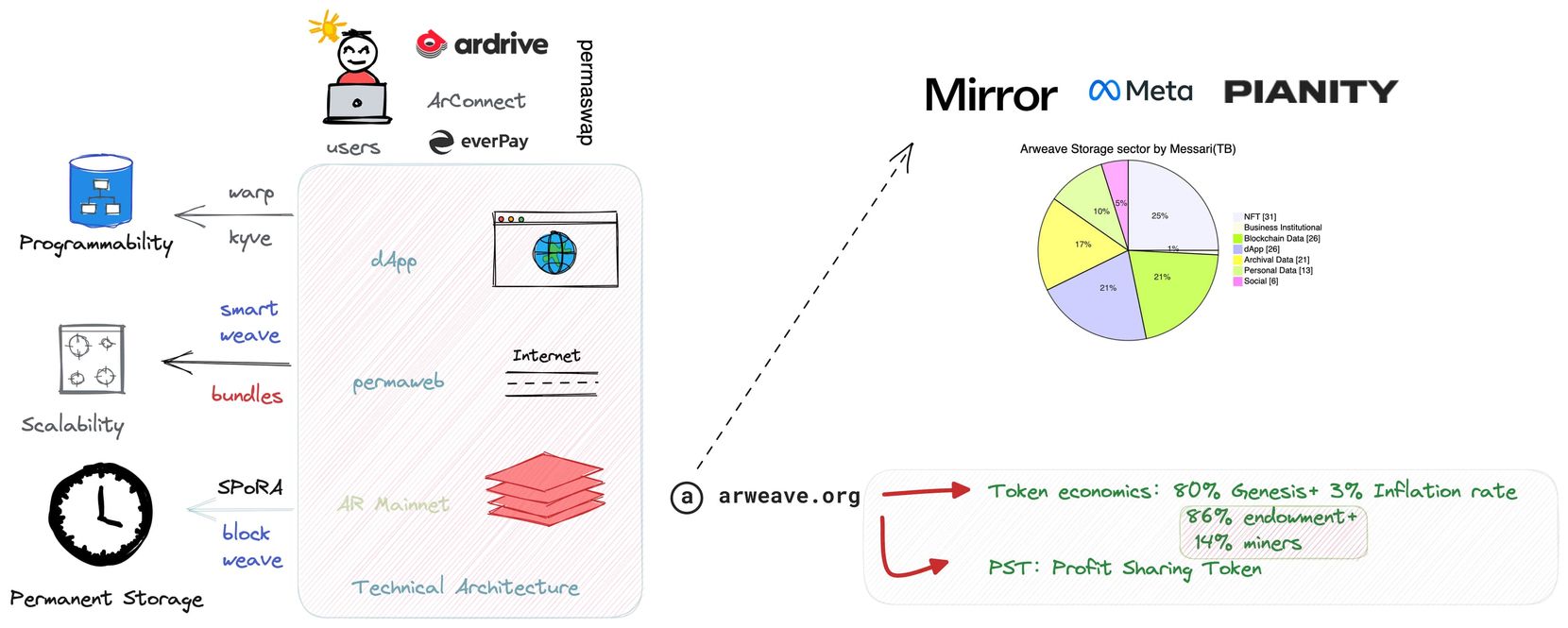
Image description: Arweave Structure
Image source: Arweave SCP Ventures
LianGuaiRT II: New Developments Since Arweave 2.6
Since the activation of Arweave 2.6 in March, it has changed the operational principles of Arweave from multiple aspects, but always revolving around the initial goal of “one-time payment, permanent storage”. The three most important innovations are as follows:
- Arweave 2.6 will introduce a dynamic pricing mechanism, where the protocol will specify the maximum hard drive speed. This allows for a systematic calculation of hard drive prices. Under this mechanism, miners using hard drives that exceed the specified speed will not receive additional rewards;

Image description: Dynamic Pricing Mechanism
Image source: Arweave SCP Ventures
- As a result, it will become more profitable for miners to use cheaper mechanical hard drives (HDDs). According to calculations, based on the current average hard drive Mean Time Between Failures (MTBF), if the Arweave mainnet wants to guarantee storage durability of at least 200 years, each piece of data will need at least 15 copies;
- Ultimately, Arweave aims to incentivize miners to store more data, especially rare data backups and data types with heavy space requirements such as audio and video. Specifically, with the updated version, Arweave will add a new data partition called LianGuairtitions, which will organize a LianGuairtitions scale of 3.6 TB to improve the scalability of data utilization.
Since the upgrade, the network scale of Arweave has smoothly surpassed 100 PB in the past six months, and the total number of transactions has exceeded 1 billion. Currently, the average number of file copies per piece is around 1000.
All of this is not only due to the Arweave 2.6 update. The Bundle standard based on ANS-104 has also contributed a large amount of data. Simply put, Bundle is a Layer 2 standard on Arweave that packages more data together and submits it to the mainnet, thereby improving the efficiency of uploading data in a single transaction. The main tools currently used are Arseeding and Bundlr, which are open-sourced by Web3Infra.
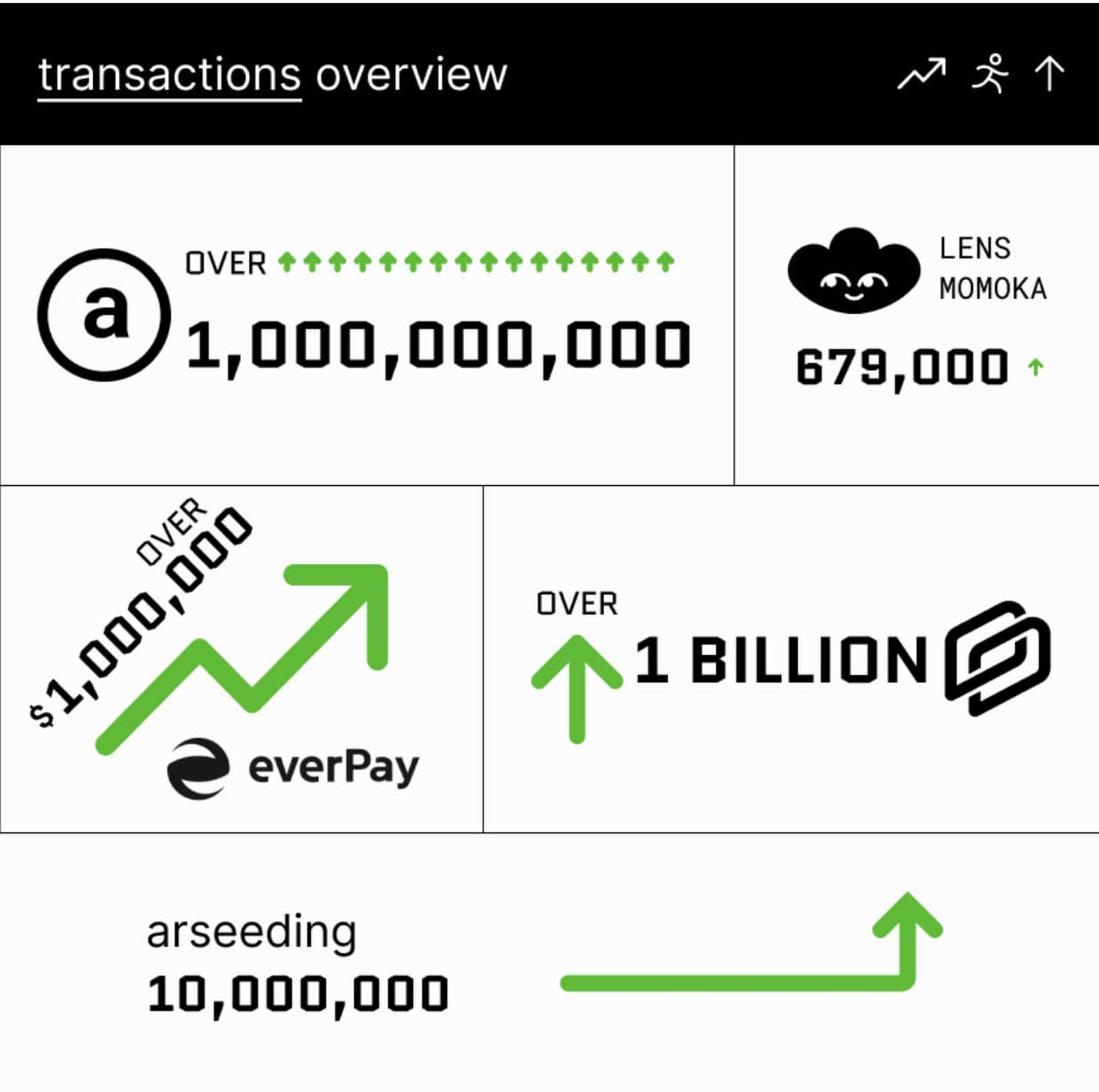
Image description: Arweave Eco Stats
Image source: Arweave SCP Ventures
DeFi and basic development tools are the main driving forces behind the growth of Arweave’s data.
Bundlr has reached a deep cooperation with Lens Protocol. As its on-chain data storage solution, Bundlr reduces its transaction fee to only $0.0003. Currently, it has achieved 679,000 on-chain transactions with a total value of $214. Moreover, Bundlr’s total data usage has exceeded 100 million, marking another milestone in the entire Arweave ecosystem.
In addition, Arseeding also surpassed 10 million transactions at the end of August, mainly driven by DeFi transactions led by everLianGuaiy. It has also expanded to more service hosting services, such as the large-scale adoption by 4everLand.
Furthermore, more underlying infrastructure is being developed. The most important ones are the adoption of UDL and UCM designed by Forward Research, as well as the $U protocol. These three will change the current simple data upload situation at the basic protocol layer and unleash more economic value.
- UDL (Universal Data License) aims to give creators more autonomy. Creators can set the length of the license period, the currency and fees for payment, and other arbitrary types. They can also synchronize these settings directly using Bundlr during the upload, and the assets will be available on Permaweb.
- UCM (Universal Content Marketplace) categorizes the content marked by UDL on Permaweb as atomic assets. It brings divisibility and tradability through smart contracts, making any format of content have transaction value, including text, images, streaming media, and even tokens and NFTs. This will fundamentally innovate the existing content creator economy.
- $U is minted at a 1:1 ratio to AR when users pay for storage fees. It can be directly traded on Permaswap and obtained when using Arseeding or Bundlr for uploads. It supports more creators in monetizing their content.
In addition, important underlying protocols are also making progress. For example, UCP (Universal Commenting Protocol) allows users to interact with content on Arweave and sign with their wallets to verify their authorship. UCP allows permanent storage of comments, preventing arbitrary censorship or deletion, giving users the freedom to express their thoughts, communicate, and foster strong communities.
To illustrate the specific use cases of these innovations, Forward Research has created a super demo product called BazAR NFT Marketplace. It supports the use of UDL and UCM, allowing NFTs to circulate and trade within the atomic asset category, and can be purchased using $U.

Image description: BazAR NFT Marketplace Tech Structure
Image source: Arweave SCP Ventures
The underlying infrastructure of Arweave is already rich enough, what is needed next is more application development and data usage. In order to provide a detailed explanation of the current data growth situation, SCP Ventures will interpret the network data since the Arweave 2.6 update.
LianGuairt III: Data Interpretation
Note: Due to limitations in the research method, the data source is viewblock.io, and the statistical time is from March 2023 to August 2023. A six-month time period is sufficient to illustrate the current network situation of Arweave.
Starting from the most basic storage cost, the storage price of Arweave is in a state of dynamic change. However, this is not the whole truth. According to the fluctuation of AR’s price, currently (September 2023), the price of storing 1 TB on Arweave is about $3500, but we need to note that this is the cost of permanent storage.
In fact, according to CoinGecko’s calculation in May, based on the price of storing 1 TB per month, Arweave only requires about $2.13, which is only 10% of Amazon S3, and it can be saved for more than 200 years.
In terms of storage scale, Arweave’s data scale has entered a steady growth phase. SCP Ventures has compiled detailed data from March to August to explain Arweave’s data explosion.
Since March, Arweave’s mainnet has maintained a high-frequency growth phase of around 100 million transactions per month. Both July and August have exceeded 100 million transactions per month. Based on this data, the transaction volume in Q2 of 2023 (April/May/June) exceeded 260 million transactions, and it is expected that Q3 will exceed 300 million transactions under the current growth trend.
Although the price of AR has declined compared to the peak of the bull market, AR’s transactions and usage are still growing rapidly. For example, stimulated by the upgrade in March, the monthly transaction volume reached 17 million AR, with an average monthly transaction volume of about 10 million (9,158,368). The transaction volume in March, June, and August exceeded 10 million, and the transaction volume began to rise in July and August, indicating further growth.
With the continuous boost of data, Arweave’s network scale has remained above 125 TB since March, and it has steadily increased by 2 TB per month for 6 months. In the bear market environment, these data are undoubtedly more real and valuable. By the end of this year, Arweave’s weave size may approach 150 TB.
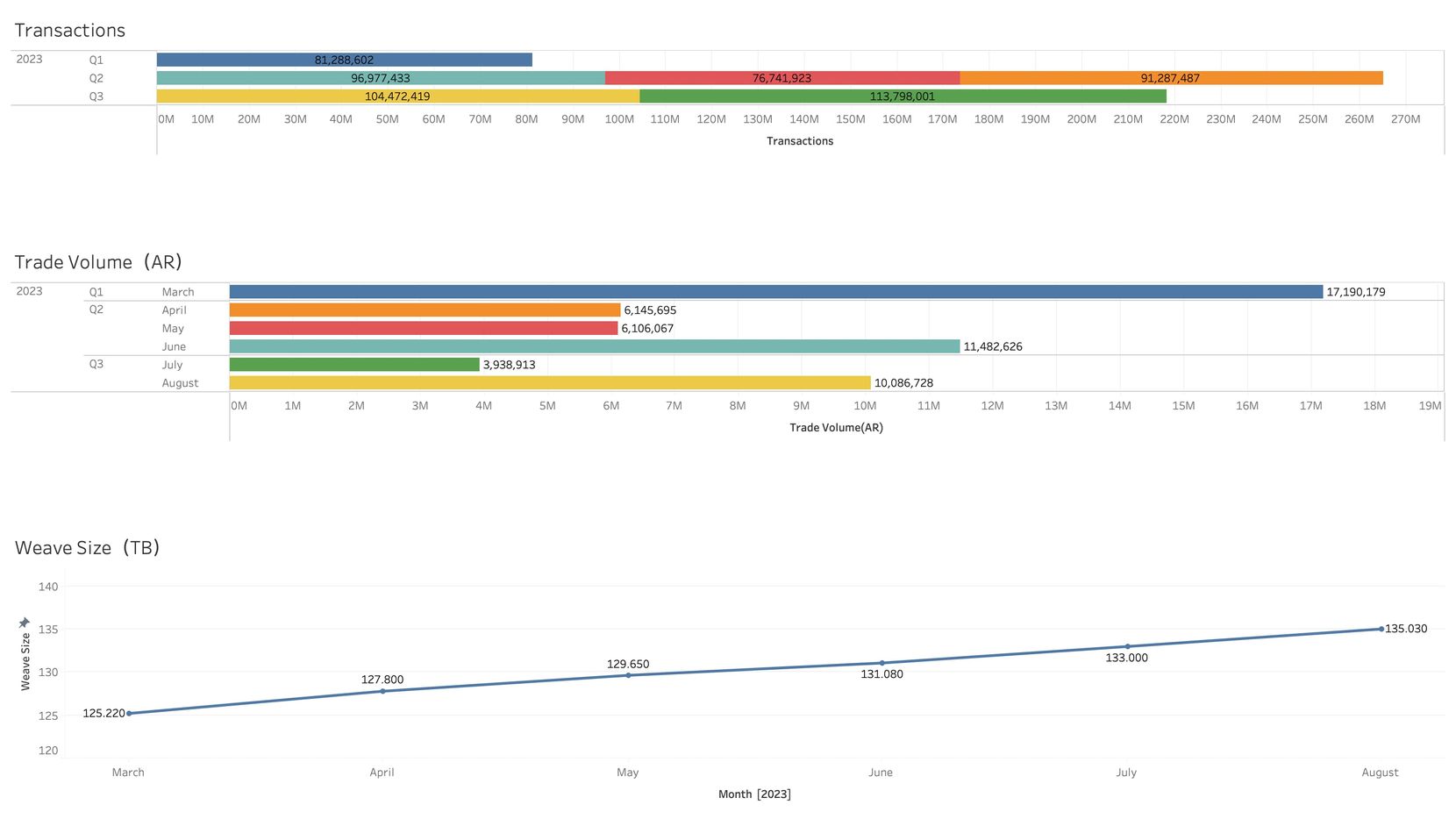
Image description: Arweave tx/trade volume/Weave Size Stats
Image source: Arweave SCP Ventures
After reviewing the data growth, the on-chain address data of Arweave is also worth paying attention to. Since March, the growth of contract addresses on the Arweave chain has started to explode, especially in April of Q2, with a monthly growth of nearly 2 million (1,919,789), and the overall data growth in that quarter exceeded 4 million.
Affected by this data, the number of active addresses on the Arweave chain has also started to grow rapidly, from 479 in March to 1042 in June, marking Arweave’s first entry into the range of over 1000 addresses.
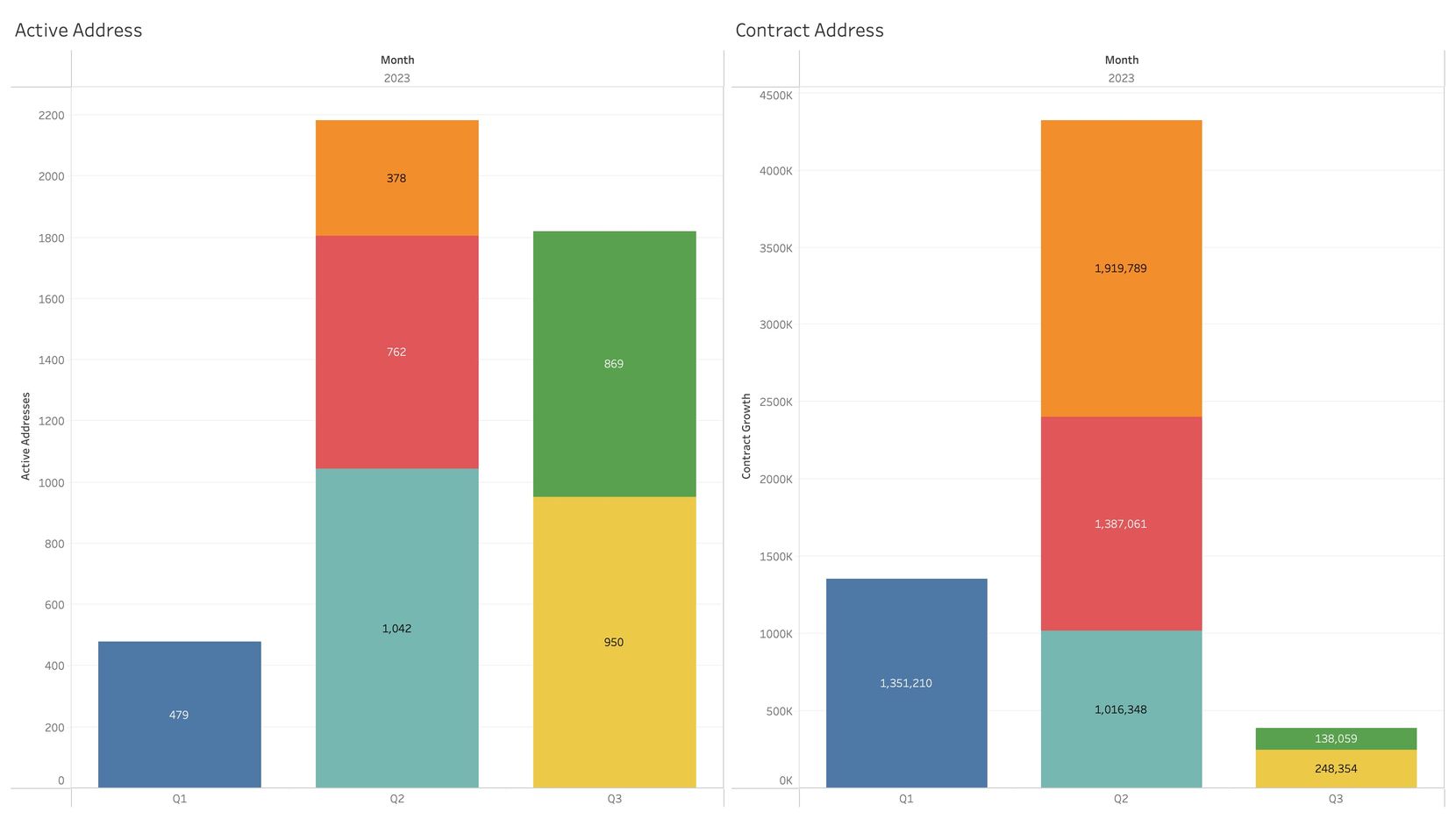
Image description: Arweave Address Stats
Image source: Arweave SCP Ventures
Overall, Arweave’s data growth has not decreased but increased in the bear market. This is inseparable from Arweave’s transformation measures and the prosperity of its ecosystem projects. From a macro perspective, Arweave’s data growth mainly relies on storage dApp applications, but there are also new trends worth paying attention to, such as DDB (decentralized database) and web hosting services, which will together constitute the main engine of Arweave’s future data growth.
And in the broader field of native crypto such as DeFi and NFT, Arweave has not stopped exploring, the most notable being the creator economy and abstract accounts, as well as DeFi practices guided by SCP theory.
LianGuairt IV: Key Developments in the Arweave Eco
According to Community Labs’ statistics, by the end of 2022, most projects in the Arweave ecosystem were development tools, but by 2023, most applications had transitioned to being application-focused.
The infrastructure for the Arweave ecosystem has been mostly completed and is gradually transitioning to ecosystem construction and market expansion.
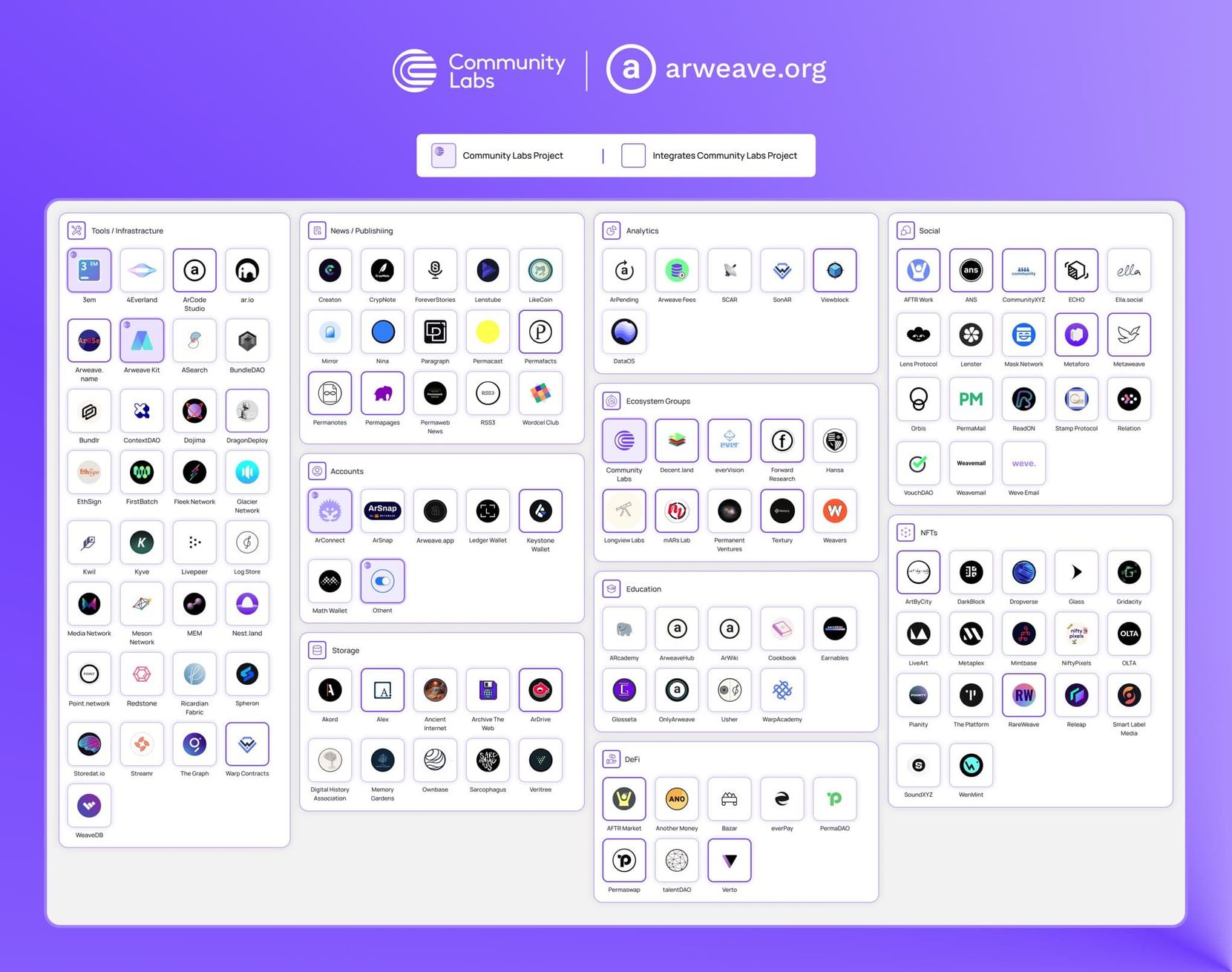
Image description: Arweave Eco
Image source: Community Labs
As an example, DDB (Decentralized Database) is an area with potential for growth. Currently, various database services have been built on Arweave, including SQL and NoSQL. In terms of operation, they follow the dual architecture of Arweave as the data storage layer and Incentive Network as the operator. Mind Network aims to build a data encryption layer using ZK + FHE, while Kwil and WeaveDB are typical representatives of SQL and NoSQL, respectively. Kwil provides high-performance services similar to MySQL, while WeaveDB aims to provide a multi-file database similar to MongoDB for non-numeric data such as files, audio, and video.

Overall, the current use cases of Arweave still mainly focus on storage services, while DDB represents a new direction for application development. These stacks will greatly enhance developers’ efficiency on Arweave.
LianGuairt V: Dev Tool & Developer Stats
According to statistics, Arweave currently has 17 full-time developers, and with part-time developers, the number of monthly active developers is around 62. In terms of trends, the activity of open-source code repositories has been increasing year by year, especially since 2023, with significant increases in the number and activity of developers.
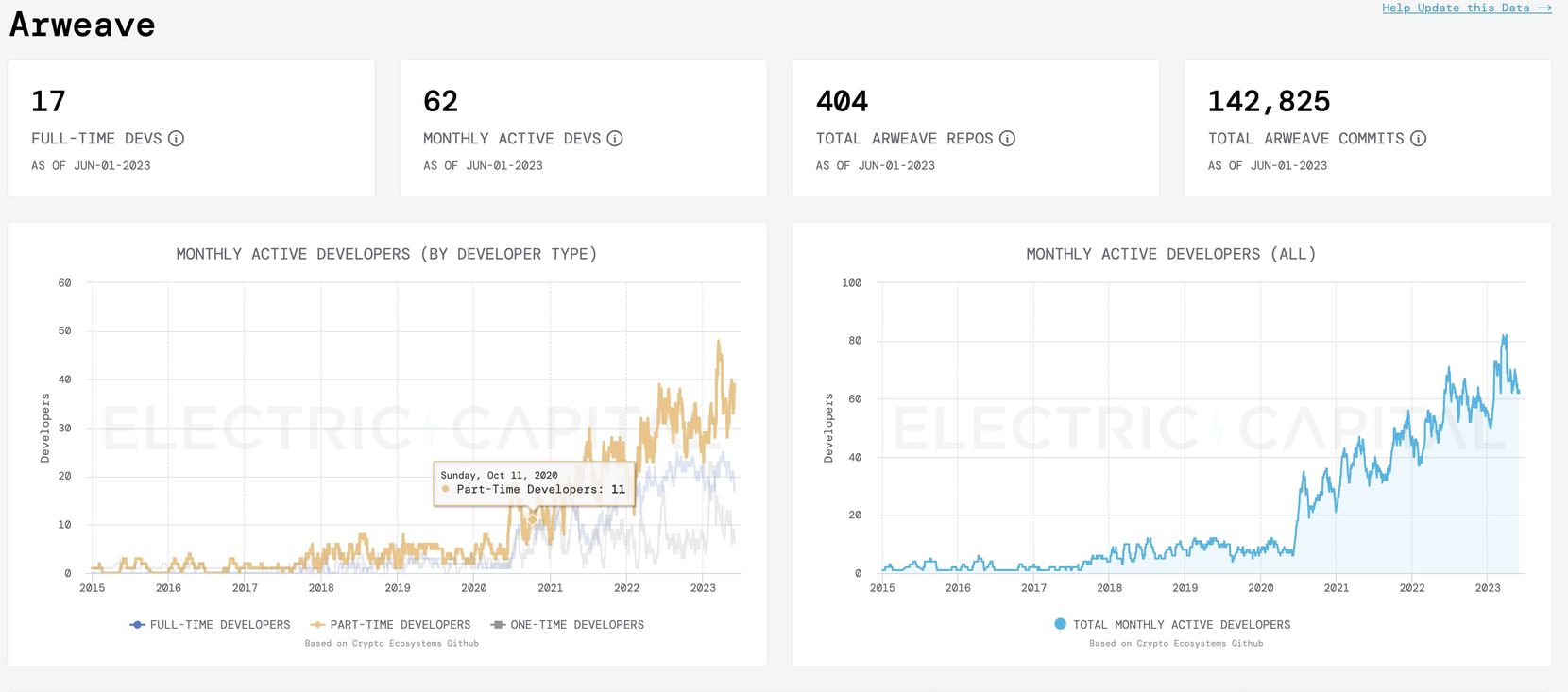
Image description: Arweave developer data
Image source: https://www.developerreport.com/ecosystems/arweave
From a developer’s perspective, Arweave can be understood as a backend framework or a public database, so it particularly needs two types of services: gateway and index building tools.
In terms of gateway design, Arseeding and Bundlr mentioned earlier can be understood as light nodes. They themselves also provide communication capabilities with the Arweave mainnet, but the Arweave mainnet still retains direct usage and interaction gateways, such as Arweave.net and AR.IO, etc.

Image description: Arweave gateway types
Image source: Arweave SCP Ventures
Among them, 4EVERLAND is also an important development facility, providing one-stop web hosting services for applications and websites built on Arweave, including multiple domains such as Arscp.Ventures using its services.
After setting up the node service, an efficient Index construction tool is also needed. Developers need to retrieve data in a timely manner. Here, two projects are mainly introduced: KNN3 and Adot.
- KNN3 and Arseeding have deep cooperation and can support real-time index services uploaded by Arseeding, and can be developed through GraphQL.
- Adot has built a full-text search service tool for the Arweave mainnet, allowing developers to retrieve any data uploaded to Arweave through Adot.
After building a complete storage, gateway (access), and index service tool, Arweave has become a decentralized cloud service provider that never stops and can meet all developers’ building and development services.
The last puzzle is how to onboard Web2 users. Currently, the consensus of everyone is abstract accounts, relying on traditional login methods such as email and mobile phone numbers, and then building encrypted wallets and on-chain accounts. It is hoped that this can solve the problem of the high entry threshold for Web2 users.
Two products are emphasized, EverID under everVision, and the othent tool incubated by Community Labs, as well as its open-source Arweave Wallet Kit.
- EverID uses WebAuthn to build a bridge between its login methods in Web2 and Web3 services. EverID can use hardware devices (Windows, iOS, macOS, and Android) to generate identity keys locally and support sharding of private keys among multiple physical devices to improve security. After local identity generation, it can activate accounts and identities within the everLianGuaiy system, and users do not need to record private keys or account addresses on the front-end page.
- Othent uses Google JWT (JSON Web Token) to register Google email on Arweave and calls Warp’s smart contract service to build an on-chain identity system.
Abstract accounts and wallet applications are different. Their goal is to lower the threshold for Web2 users to use blockchain, while Arweave’s large-scale use requires high-performance products, such as the most basic DeFi infrastructure and cross-chain bridges to other public chains.
Unlike pure storage services, complex DeFi and cross-chain bridges are very difficult to build for non-EVM public chains, but once they can operate independently and stably, they will have a driving effect on the entire ecosystem.
LianGuairt VI: Conclusion
In 2023, Arweave celebrated its fifth anniversary, starting from the concept of permanent storage and gradually building a complete technical architecture, which can effectively store data for more than 200 years, standing out among many storage projects.
Arweave has grown into the most decentralized storage infrastructure in the Web3 field, with the goal of building an everlasting library for the entire human civilization, storing all the achievements of human civilization so far.
Under this guiding principle, Arweave has expanded from initial personal storage to enterprise-level storage, from static data to the DDB field, from a single storage service to data availability services, and from experimental cooperation with Meta NFT to the wise choice of Lens, all of which have proven the reliability of Arweave.
References:
- $U-Niverse
- Introducing BazAR!
- Arweave
- Introducing the Universal Data License
- Universal Content Marketplace
- Centralized vs Decentralized Storage Cost (2023)
- https://www.arweave.org
- http://fwd.arweave.dev
- Arweave (AR) Research Reports | Messari
- Crypto Fundamental Analysis — ‘The Arweave’ : Good Concept, Solid Tech 💾
- twitter/MessariCrypto
- Decentralized Storage: A Primer
Like what you're reading? Subscribe to our top stories.
We will continue to update Gambling Chain; if you have any questions or suggestions, please contact us!